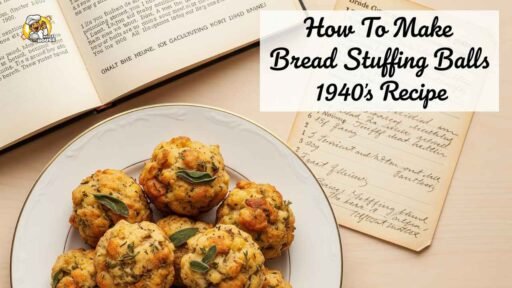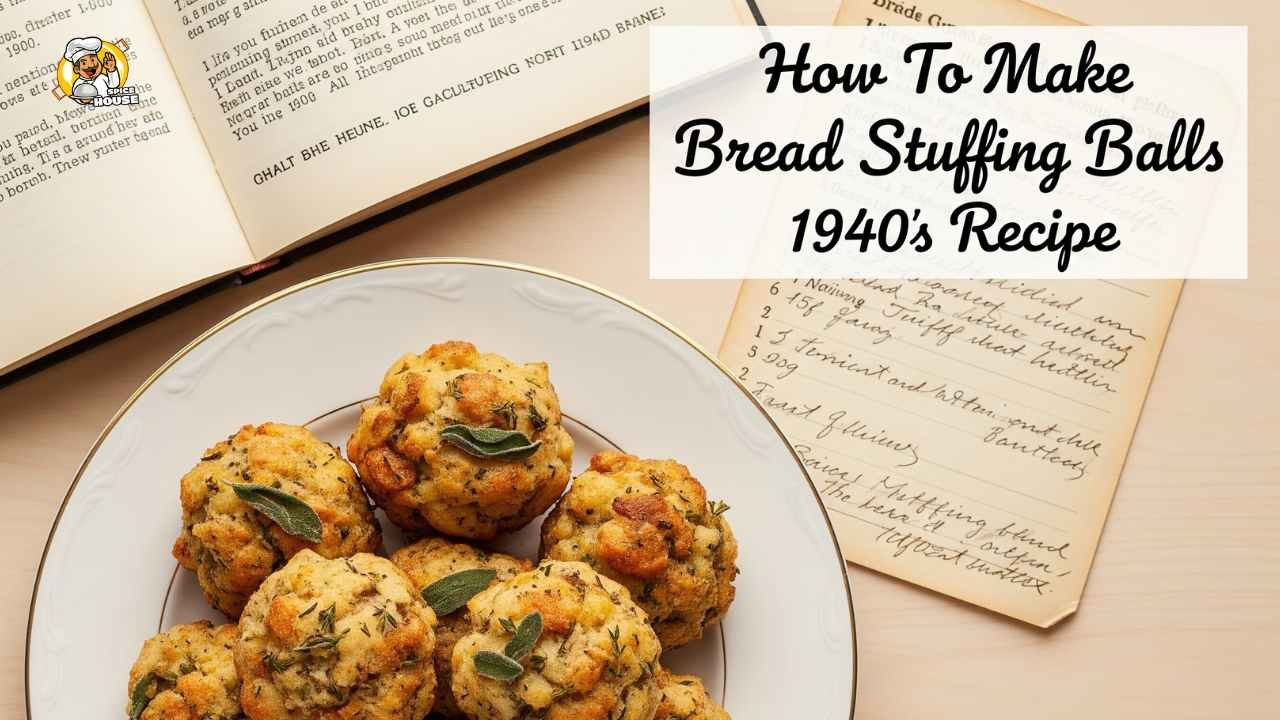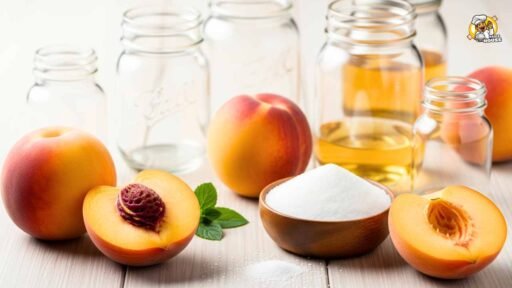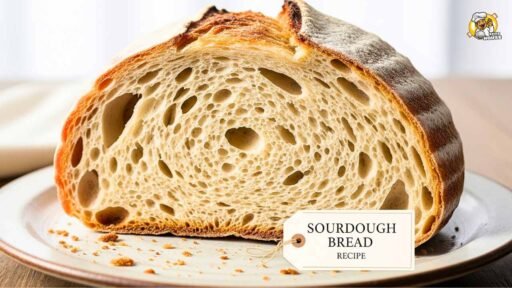Here’s a hard number to chew on: the U.S. Department of Agriculture estimates that 30–40% of America’s food supply gets wasted each year. And across the Atlantic, the U.K.’s Waste and Resources Action Programme has reported that households throw away around 20 million slices of bread a day. That’s not a typo. In a season when holiday spreads grow larger, waste often does too.
At the same time, a counter-trend keeps gathering heat. Vintage recipes from the 1930s and 1940s—simple, thrifty, resilient—are back in home kitchens. Stuffing balls made from yesterday’s bread belong to this old-school playbook. The controversy, if you can call it that, sits right on the shelf: do consumers return to scratch cooking or stick with boxed stuffing mixes from brands like Pepperidge Farm, a Campbell Soup Company label with decades of holiday dominance? The answer affects more than dinner. It shapes how grocers plan promotions, how CPG companies message value, how investors handicap holiday sales, and how households manage budgets and waste. Consumers feel the pinch. Employees in retail feel the rush. Investors watch the line on the earnings call.
The Data:
-
According to the USDA, Americans waste 30–40% of the food supply. Bread is among the most commonly binned staples. ReFED’s most recent analysis has U.S. food waste at roughly 38% of the supply by weight when you tally what goes unsold or uneaten across the chain.
-
WRAP, the U.K. food waste nonprofit, has highlighted bread as a repeat offender: roughly 20 million slices get thrown out daily in British households. No one needs a cross-Atlantic study to know stale slices pile up fast.
-
Inflation sharpened these habits. Food-at-home prices spiked 13.5% at their 2022 peak, the fastest clip since 1979, per the Bureau of Labor Statistics. Price pressure cooled since then, but shoppers built new muscle memory: stretch pantry staples, cook from scratch, repurpose leftovers. That stickiness matters.
Quick Guides: How To Make Bread Stuffing Balls 1940s Recipe:
-
Cube day-old bread (white, country, or rye), dry it, then mix with sautéed onion, celery, butter, herbs (sage, thyme), egg, and broth.
-
Form into balls, chill briefly to set, and bake until golden with a tender center.
-
Serve with gravy or pan drippings. This is 100% make-ahead friendly.
How To Make Bread Stuffing Balls 1940s Recipe (Step-By-Step Guide)
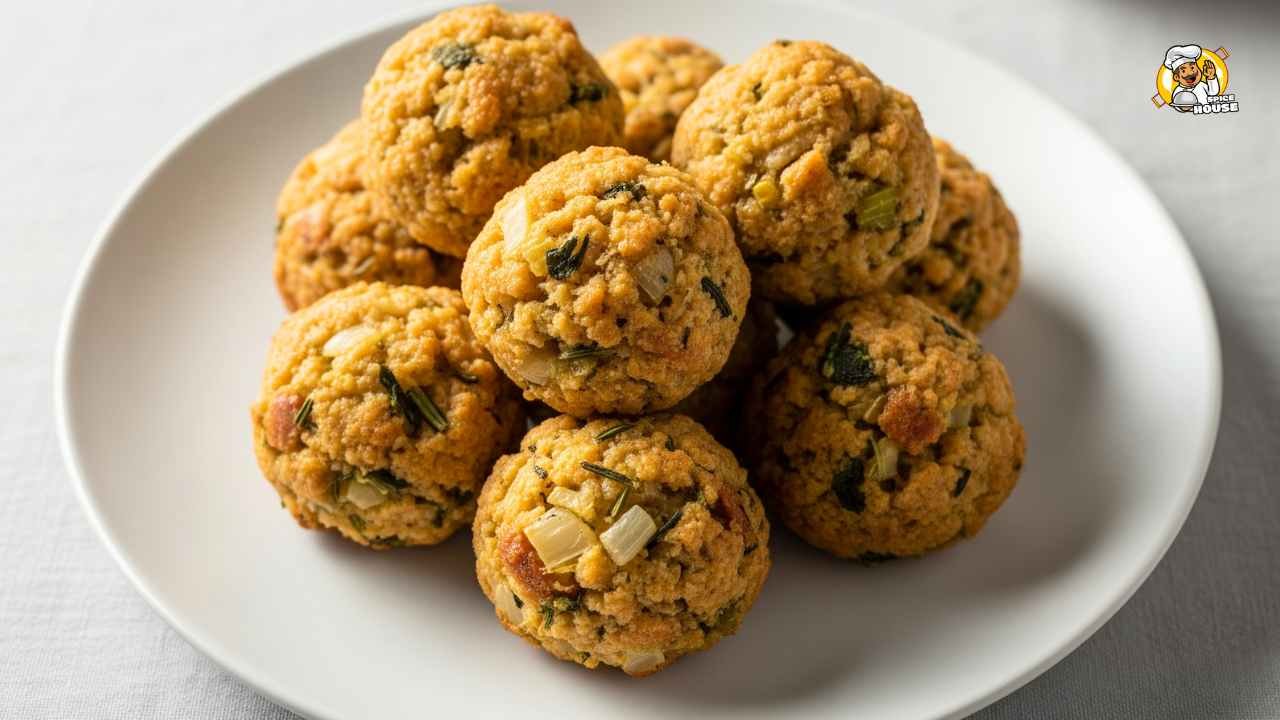
Step 1: Choose, cube, and dry the bread like a 1940s home economist
Start with what you have. The 1940s mindset rejected waste on principle, so stale bread was a feature, not a flaw. White sandwich loaves, farmhouse boules, or even light rye all work. Avoid highly seeded artisan breads (their sharp seeds can puncture the delicate structure of a stuffing ball) and skip sweet loaves. Aim for about 1 pound of bread for 12 to 14 medium balls.
Cube the bread into 1/2-inch pieces. You want enough surface area to absorb flavor and enough heft to hold its shape. Dry the cubes two ways. If you’ve got time, spread them in a single layer on sheet pans and air-dry overnight. If you don’t, set your oven to 275°F and toast until the bread feels dry to the touch and a bit brittle, 25–35 minutes, stirring once. Don’t brown it deeply, the color will come later. Drying does two things. It opens tiny pores that suck up broth, and it gives you control over texture so the balls don’t collapse into mush.
The 1940s twist is restraint. No pre-seasoned crumbs. No short-cuts that box you in. Dry bread cubes are a blank canvas that welcome butter, onion, and sage. If your cubes feel too hard, don’t panic. The binder will soften them. If they feel too soft, dry them for another five minutes. You’re in charge here.
Step 2: Build a flavor base classic to mid-century kitchens
Grab a heavy skillet. Melt 6 tablespoons of butter over medium heat until it foams. Add 1 large onion, finely chopped, and 3 ribs of celery, also finely chopped. Sprinkle a pinch of salt and cook, stirring often, until the edges go translucent and sweet, 8–10 minutes. This isn’t a sear-it-fast moment; you’re coaxing flavor, not chasing color.
Now the herb trio that defined American stuffing long before boxed mixes: 1 1/2 teaspoons rubbed sage, 1 teaspoon dried thyme, and 2 tablespoons chopped fresh parsley. If you only have dried parsley, it’s fine. Warm the herbs in the butter and aromatics for 30 seconds to bloom their oils. Optional, but very 1940s: add 1/2 cup finely chopped mushrooms or cooked, minced giblets if you have them. Many households did. They add a savory bass note without changing the soul of the dish.
Season with freshly ground black pepper. Taste. The butter should smell nutty and green with sage. If it smells flat, add a scrape more thyme. Here’s the thing: this step is where your stuffing balls earn their reputation. Butter carries flavor. Aromatics deliver it. Load the pan too fast or keep the heat too high, and you’ll scorch the notes you want. Take it slow. Turn off the heat and let the mixture cool for five minutes. Warm fat binds better than hot fat when you mix it into bread.
Step 3: Make a binder that’s sturdy but not stodgy
In a large bowl, whisk 2 eggs until loose. Add 1 1/2 cups warm chicken or turkey broth and 1 teaspoon kosher salt. If your broth is salty, cut the added salt in half. Pour in your cooled butter-onion-celery-herb mixture and stir to combine. You just built the binder—the thread that ties those dry cubes into tender spheres.
Fold the dried bread into the wet base with a wide spatula. Don’t mash; lift and turn. Watch the mix as it hydrates. You want the cubes soft at the edges but still distinct. If it looks dry, add broth 2 tablespoons at a time until it clumps when squeezed without leaking liquid. If it looks soupy, toss in a handful more dried cubes. A common ratio that works: for each pound of dried bread, count on 6 tablespoons butter, 2 eggs, and 1 1/2 to 2 cups broth. The age of your bread changes the math, so trust your eyes and hands more than a fixed line.
Taste for seasoning. Bread blunts salt. Add a pinch more if needed. Prefer a richer 1940s profile? Stir in a tablespoon of melted schmaltz (rendered chicken fat) or drippings from a roast pan. That was standard in a lot of wartime kitchens. The goal is a mixture that hangs together—supple, not sticky, glossy with butter, fragrant with sage. This smells like Sunday at your great-grandmother’s.
Step 4: Form, chill, and set the structure
Clear a sheet pan and line it with parchment or a light film of butter. Wet your hands slightly; it keeps the mixture from clinging. Scoop roughly 1/3 cup of stuffing and press it into a ball. Don’t pack too hard. Think snowball, not stress ball. You’re aiming for a golf ball to a small tangerine size. Consistent size helps everything bake evenly.
Place the balls on the sheet with a bit of breathing room. You should get 12–14. Brush the tops with a little melted butter or drippings. Then chill the tray, uncovered, for 20–30 minutes. This step feels fussy, but it sets proteins in the egg and firms the fat so the balls hold shape in the oven. Skipping the chill is the number one reason stuffing balls slump.
Want a wartime-era trick for extra structure? Dust the tops with a whisper of plain breadcrumbs or crushed saltines. The thin crust helps lock in moisture. Another trick: fold in a tablespoon of chopped fresh parsley right before rolling, which brightens the interior color.
If you’re making ahead, stop here. Cover and chill up to one day. Stuffing balls also freeze well at this stage. Freeze on the tray until solid, then store in a zip bag. Bake from frozen, adding a few extra minutes. That kind of make-ahead flexibility is why they popped up on holiday tables back then—they let the oven do the work while you carve.
Step 5: Bake, baste, and finish like it’s 1948
Heat the oven to 375°F. Slide the tray of chilled stuffing balls onto the middle rack and bake 18–25 minutes, turning the pan once for even browning. Midway through, brush with a little hot broth or pan drippings to build gloss and flavor. You’re watching for a golden exterior and a center that hits 165°F. If you don’t use a thermometer, tug one open. It should be steamy and moist, not doughy.
For a crisper shell, run them under the broiler for 60–90 seconds at the end. For extra savor, park the baked balls around the turkey in the last 10 minutes to catch drippings. That’s a 1940s move used to marry flavors when ovens were small and roasts were big.
Serve hot with gravy, onion jam, or cranberry sauce. A platter of stuffing balls travels better than a casserole, so they’re ideal for potlucks. Leftovers reheat well in a skillet with a dab of butter. Variations? Swap butter for half olive oil if you need to stretch dairy. Fold in chopped nuts for crunch if you like. Or go meatless with vegetable stock and mushrooms. You can also press the mixture into a log, chill, and slice into rounds for a retro canape. The base recipe stays the same; the format flexes to your table.
The People:
Food writer M.F.K. Fisher, whose 1942 book How to Cook a Wolf guided wartime kitchens toward thrift without apology, famously wrote, “First we eat, then we do everything else.” The point wasn’t frugality for its own sake. It was sanity. Use what you have. Cook it well. Don’t waste it.
Modern industry voices echo the logic, if in different words. Grocery analysts who follow holiday categories say scratch methods don’t kill boxed mixes; they sit right alongside them in the same cart. “Nostalgia sells,” one category manager likes to say, “and thrift keeps the sale.” Look, nobody expects Pepperidge Farm to roll over. On seasonal endcaps, they own mindshare. On investor calls, Campbell Soup often stresses value, convenience, and trust. Those three words compete with “made from what’s already in my kitchen” in a year when families still feel cautious. Sources say shoppers toggle—unbox for one meal, repurpose for the next—and the brands that recognize the rhythm win loyalty.
You also hear from chefs who run throwback nights and pop-ups. They’ll tell you stuffing balls hit a sweet spot: grain, fat, herb, and a little crisp crust that tastes like home. And from sustainability pros, the advice is pragmatic: don’t romanticize waste reduction. Measure it, then set a target. If a batch of stuffing balls keeps bread out of the bin and draws down the need for another side, you’re making a small but real dent.
The Fallout:
So what happens if the 1940s recipe playbook keeps winning attention? Start with households. A tray of stuffing balls turns a half-loaf and pantry staples into a star side. That’s money saved and waste reduced. ReFED’s modeling shows the biggest wins come from simple behavior shifts multiplied across millions of kitchens. Bread is easy to redirect. The emissions footprint tied to wasted bread—baked, packaged, shipped, and then tossed—drops when people re-route it into dinner. That’s not just feel-good; it’s measurable.
Now look at grocers. Expect more “save your scraps” signage around the holidays. Expect QR codes on bakery racks that lead to simple stuffing-ball guides. Stores that bake in-house have a painless lever: markdown yesterday’s loaves with a recipe card clipped to the bag. Employees benefit too. Simpler questions, fewer returns, happier shoppers. It’s retail blocking and tackling.
For packaged brands, especially in the seasonal aisle, the picture is more nuanced. Pepperidge Farm still wins November endcaps. Their mixes are beloved for a reason. But scratch revival and private-label expansion exert pressure on unit growth. You can already see how brands respond: smaller pack sizes at sharp price points, premium limited-edition flavors to justify margin, and cross-merch with stock and gravy for a bundled value message. Will they also lean into the retro wave? That’s the move I’d watch. A “heritage” line that riffs on mid-century flavors—sage-and-onion with mushroom, rosemary brown butter, even a stuffing-ball kit—could do real business if it threads the needle between convenience and craft.
Investors? Seasonal category check-ins will matter. Campbell’s Meals & Beverages business faces the same headwinds and tailwinds as peers: consumers trading down but trading up for holidays, pantry staples steady, and premium sets choppy. Any signal that scratch cooking steals share or that private label gains at the shelf could nudge expectations. But it’s not a binary war. Most households mix modes. The bigger fallout lands in marketing. Content that shows people how to use what they have builds goodwill. It’s cheap. And it meets this moment better than a glossy ad of a perfect table nobody recognizes.
Zoom out to culture. When people reach for 1940s recipes, they borrow a mindset as much as a method. Use it up. Make it do. That mantra re-centers holiday cooking around basics: butter, onion, sage, time. If that means fewer foil trays of untouched sides headed to the trash, great. If it also means a little less reverence for corporate spin and a little more pride in home skill, that’s an impact brands will need to respect.
Practical Buying Guide for the Recipe:
-
Bread: Day-old white or country loaves are ideal. If buying fresh, slice and dry it yourself.
-
Fat: Unsalted butter delivers classic flavor. Drippings add depth if you have them.
-
Aromatics: Yellow onion and celery are non-negotiable. Buy fresh; pre-chopped runs watery.
-
Herbs: Dried sage and thyme are true to the era. Fresh parsley brightens.
-
Binder: Eggs and a good broth. If the budget is tight, boost the water with a bouillon cube, but taste for salt.
Common Mistakes and Fixes:
-
Balls fall apart: Mixture too dry or not rested. Add a splash of broth and chill before baking.
-
Mushy texture: Bread not dried enough. Dry cubes longer next time; broil briefly to crisp.
-
Bland flavor: Under-salted base. Season the butter-onion-celery stage; don’t rely on finishing salt.
-
Greasy feel: Too much fat or not enough bread proportionally. Fold in extra cubes to balance.
Why This 1940s Recipe Still Works:
-
Technique over gadget: Dry bread, low-heat aromatics, a balanced binder.
-
Flexible format: Bake balls, pan-sear patties, or nestle around a roast.
-
Zero waste ethos: Saves bread, uses drippings, repurposes stock bones.
-
Scales well: Doubles without drama, freezes before baking, and reheats crisp.
A Note on Food Safety:
Bake stuffing balls to an internal 165°F. If you fold in giblets or raw sausage, cook those add-ins fully before mixing. Don’t stuff them inside a roast; they cook more evenly and safely on a tray.
Two-Speed Holiday Strategy For Busy Households:
-
Speed Mode: Use boxed mix for the big day, then turn leftover bread from brunch into stuffing balls for the weekend. No judgment.
-
Scratch Mode: Make a double batch of stuffing balls on Wednesday. Bake half on Thursday, freeze half for a no-stress December dinner.
FAQs You Might Be Wondering About:
-
Can I make them gluten-free? Yes. Use a sturdy gluten-free loaf, dry it well, and add an extra egg for insurance.
-
Can I skip eggs? You can. Increase the broth a bit and stir in a tablespoon of ground flax soaked in warm water to help bind.
-
Can I air fry? Yes. 360°F for 10–14 minutes, shaking once. Brush with fat so the surface doesn’t dry out.
The Bigger Picture on Trends
Butterball’s Turkey Talk-Line triages more than 100,000 questions each holiday season. Most are about timing, but a surprising number ask how to handle stuffing. Google searches for stuffing spike like clockwork in November. The broader pattern is obvious: people want confidence. Some want convenience. Others want control. The sweet spot is a recipe that proves both. A tray of stuffing balls checks that box: minimal equipment, forgiving method, and a hopscotch of scents that travel through a house the way memories do.
For brands with heritage like Pepperidge Farm, that nostalgia is a double-edged sword. It powers loyalty, yet it invites comparisons to “how grandma did it.” When budgets feel tight, the scale tips toward methods that start with what’s already paid for. If I ran the seasonal set, I’d bundle a small bag of their classic mix with a day-old bakery loaf and a card that says: “Stretch it. Make a tray of stuffing balls.” That’s cooperation, not cannibalization.
Closing Thought
If millions of kitchens turn orphaned bread into crisp, sage-scented stuffing balls this season, the impact won’t stop at the table. It chips away at waste, it nudges brands to adapt, and it reminds investors where value really lives in habits that stick. The only question is which player moves first: will a legacy name like Pepperidge Farm roll out a heritage stuffing-ball kit, or will home cooks quietly reshape the holiday aisle one thrifty, golden bite at a time?

